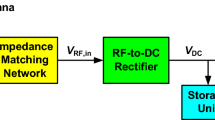Abstract
In this paper we present a minimal sized CMOS thyristor based oscillator, which is able to provide a clock signal of \(\approx\)20 Hz. The oscillator was designed as a timer or clock generator for autonomous microsystem applications. The chip area of the oscillator is 18 µm by 35 µm and it is able to run for more than 10 min when supplied from a 10 nF capacitor. The oscillator’s time constant is determined by MOS transistor leakage currents and MOS capacitances. It could be shown that there is no need for large on chip resistors and capacitors. A chip was fabricated in a standard 180 nm CMOS technology and evaluated. The measured power consumption at 200 mV and 1.8 V supply voltage is 3 and 232 pW, respectively. We also investigated the ability of the oscillator to operate without a package by measuring the influence of incident light to current consumption and oscillation frequency. The possibility to tune the frequency of thyristor based oscillators has been investigated with a second test chip.












Similar content being viewed by others
References
Chang, B. S., Kim, G., & Kim, W. (1995). A low voltage low power CMOS delay element. In Twenty-first European solid-state circuits conference, 1995. ESSCIRC ’95 (pp. 222–225).
Kim, G., Kim, M. K., Chang, B. S., & Kim, W. (1996). A low-voltage, low-power CMOS delay element. IEEE Journal of Solid-State Circuits, 31(7), 966–971. doi:10.1109/4.508210.
Lee, Y., Kim, G., Bang, S., Kim, Y., Lee, I., Dutta, P., Sylvester, D., & Blaauw, D. (2012). A modular 1 mm\(^{3}\) die-stacked sensing platform with optical communication and multi-modal energy harvesting. In 2012 IEEE international solid-state circuits conference digest of technical papers (ISSCC) (pp. 402–404). doi:10.1109/ISSCC.2012.6177065.
Lin, Y. S., Sylvester, D., & Blaauw, D. (2007). A sub-pW timer using gate leakage for ultra low-power sub-Hz monitoring systems. In Custom integrated circuits conference, 2007. CICC ’07 (pp. 397–400). IEEE. doi:10.1109/CICC.2007.4405761.
Mahato, A. (2014). Ultra low frequency CMOS ring oscillator design. In 2014 Recent advances in engineering and computational sciences (RAECS) (pp. 1–5). doi:10.1109/RAECS.2014.6799627.
McCaskill, J. S., von Kiedrowski, G., Oehm, J., Mayr, P., Cronin, L., Willner, I., et al. (2012). Microscale chemically reactive electronic agents. International Journal of Unconventional Computing, 8(4), 289–299.
Mohamad, S., Tang, F., Amira, A., Bermak, A., & Benammar, M. (2013). A low power oscillator based temperature sensor for RFID applications. In 2013 5th Asia symposium on quality electronic design (ASQED) (pp. 50–54). doi:10.1109/ASQED.2013.6643563.
O’brien, D., Liu, J., Faulkner, G., Sivathasan, S., Yuan, W., Collins, S., Elston, S., Pithamiron, V.: Design and implementation of optical wireless communications with optically powered smart dust motes. Selected Areas in Communications, IEEE Journal on 27(9), 1646–1653 (2009). DOI 10.1109/JSAC.2009.091214
Pister, K. (2004). An ultra-low energy microcontroller for smart dust wireless sensor networks. In 2004 IEEE international solid-state circuits conference, 2004. Digest of technical papers. ISSCC (Vol. 1, pp. 316–317). doi:10.1109/ISSCC.2004.1332721.
Saft, B., Schafer, E., Jager, A., Rolapp, A., & Hennig, E. (2014). An improved low-power CMOS thyristor-based micro-to-millisecond delay element. In 40th European solid state circuits conference (ESSCIRC 2014) (pp. 123–126). doi:10.1109/ESSCIRC.2014.6942037.
Scott, M., Boser, B., & Pister, K. (2003). An ultralow-energy ADC for Smart Dust. IEEE Journal of Solid-State Circuits, 38(7), 1123–1129. doi:10.1109/JSSC.2003.813296.
Warneke, B., Last, M., Liebowitz, B., & Pister, K. (2001). Smart dust: Communicating with a cubic-millimeter computer. Computer, 34(1), 44–51. doi:10.1109/2.895117.
Acknowledgments
This research leading to these results has received funding from the European Union Seventh Framework Programme (FP7/2007–2013) under Grant Agreement 318671 (MICREAgents).
Author information
Authors and Affiliations
Corresponding author
Rights and permissions
About this article
Cite this article
Funke, D.A., Mayr, P., Maeke, T. et al. Ultra low-power, -area and -frequency CMOS thyristor based oscillator for autonomous microsystems. Analog Integr Circ Sig Process 89, 347–356 (2016). https://doi.org/10.1007/s10470-016-0799-9
Received:
Revised:
Accepted:
Published:
Issue Date:
DOI: https://doi.org/10.1007/s10470-016-0799-9




